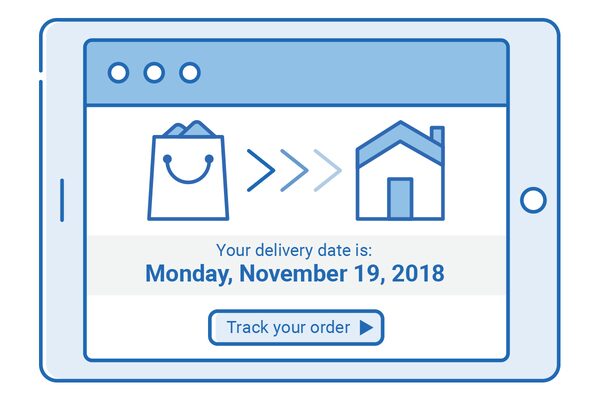
ISTOCK.COM
How to build a better workflow
Millions of Canadians shop online because it makes life easier. However, they’re unware of what goes on behind the scenes of a website. Meanwhile, your back-end operations are constantly working to fulfill promises. And every stage of the workflow is critical – from taking an order, to processing it and then delivering it.
The equation is simple: the better your back-end operations, the better the customer experience. That’s easier said than done due to the urgency of day-to-day demands that keep many merchants from planning to build and optimize operations. You may be struggling to find the insights that will guide you through common challenges.

The Shopper Path to Purchase
A shopper’s path to purchase involves: brand discovery, browsing, ordering, receiving – and possibly returning. It’s your back-end operations that power this process. Near-flawless execution in your e-commerce operations is critical. Plus, the entire end-to-end process, from receiving an order to processing a return, is about keeping your delivery promise.
THE DELIVERY PROMISE COMES FIRST

A delivery promise can be the start of a beautiful relationship – a powerful driver of acquisition and retention. Before placing an order, shoppers want to know when and how they will receive their package. Your delivery promises, and your confidence in them, will depend on the effectiveness of the e-commerce operations behind them.

THE POWER BEHIND YOUR E-COMMERCE OPERATIONS
Successful merchants know that an optimized workflow empowers your delivery promises. The time spent focusing on the critical steps involved in making an efficient process is time well spent:
Receiving and managing orders
Whether you’re selling from your own site, in-store, a marketplace or via third parties, optimizing order-processing is the first step in initiating your commitment to the customer.
Receiving an order starts the clock on your delivery promise. How well you manage, and how quickly you process that order shapes brand perception. Done correctly, it will harness a competitive advantage.
E-commerce platforms can provide you with basic inventory management. As you grow, you may need to invest in additional technology to sync inventory across multiple channels and manage increasing complexity in processing more orders.
Sorting orders
Managing orders begins with sorting them, and you’ll need to prioritize at the pick and pack stage. Sort options include:
- First-in-first-out (FIFO): Ship orders placed the previous evening until your cut-off time. Ideal for processing a handful of orders.
- Speed: Prioritize next-day-delivery orders, and possibly those that have to travel further (e.g. Vancouver to Atlantic Canada).
- Customer-service focused: Prioritize exchanges or replacements. Or delight your most loyal customers.
- Product deliverability: Ship when all items in an order are in stock.
FULFILLMENT SPACE
Upgrading
Have you outgrown your initial fulfillment set-up? Before you move to a larger space, consider your forecasted growth. You don’t want to outgrow the new space too fast or lease more than you need.
Outsourcing
Some retailers engage third-party logistics (3PL) to manage their e-commerce fulfillment. While owning warehouse management gives you control of your distribution processes, using an established 3PL provider allows you to focus on other areas of your business.
Picking and packing
Fulfillment is the beehive of your operation, where an inventory item becomes the parcel you ship. Effective pick-and-pack processes are all about managing cost, minimizing errors and meeting customer expectations.
45 per cent of shoppers expect orders to be fulfilled within a day.
Which picking method is right for you?
- Basic – for a single order
- Batch – software-driven for several orders
- Zone – tech-enabled for larger warehouse
Packaging
How well you pick and pack depends on how you access inventory, optimize packaging for your product mix, organize the right tools and space to process orders. Choosing the right packaging can be challenging. You need to optimize the number of boxes in use, protect items in transit and minimize extra space, which can increase shipping costs.
INSIDER TIPS:
Think about how to receive incoming inventory, where to store it, the location of packing stations and how to separate outgoing orders.
Place your fastest-moving products in an area that’s easy to access and quick to replenish.
Stock your packing station with supplies and tools within reach. Assemble shipping boxes in advance.
If you sell a variety of products, you may have three or four box sizes. If your product range is limited, one or two may suffice.
SHIPPING
This is your last chance to ensure an exceptional delivery experience. At this stage, it’s all about printing labels and managing logistics. There are free online shipping tools, available through your shipping or e-commerce partner, that can help you print labels quickly and effectively. As you grow and need to manage increased volumes, consolidate cross-channel orders and batch-print labels – more sophisticated shipping solutions may better suit your needs.
Many merchants start out using an office printer to generate labels. Thermal printers are best for large batches. You also need a scale to weigh parcels and a measuring tape. Many merchants, who have only a few shipments per week, bring them to the post office. With enough volume, pickup service will save time.
To get your hands on insider information and best practices for optimizing your e-commerce operation, download the eBook.
Content produced by advertiser. The Globe and Mail was not involved in its creation.